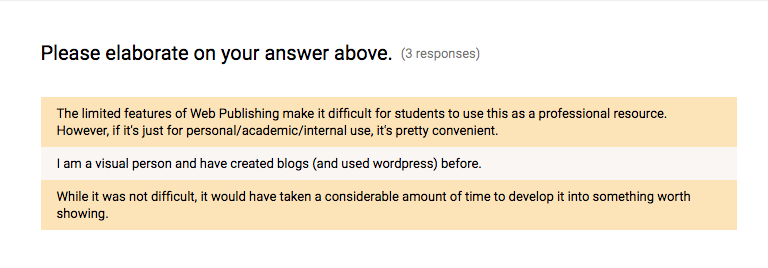
What is Kahoot!? Is a game-based learning platform that makes it easy to create, share and play learning games or trivia quizzes in minutes. Title: Integration of ePortfolios into ITE: The learners perspective 1 Integration of e-Portfolios into ITE The learners perspective. Derek Young; 2 (No Transcript) 3. E-Portfolio can be used to refer to a system or a collection of tools that support e-portfolio related processes (such as collection, reflection, annotation, etc.).
What are They?
A useful way of evaluating learners' deep learning can happen through having students write blog posts (reflections on learning) or create a portfolio (collection of reflections and examples of work) or build a website (collection of learning examples). All three of these activities can be done with a blogging platform - like VIUBlogs (powered by the software WordPress).
Faculty and students can login with their VIU accounts and begin creating blogs, eportfolios or websites.
Learn more about using: VIUBlogs

Blogs provide a reflective space for students to record their thoughts, ask questions, engage in debate and participate in a community which extends well beyond the walls of the physical classroom. A major feature of blogs is the ability for other online readers to discuss, comment on, create links to, and share the content found on the blog. Comments are usually added to each individual entry are often left in a conversational manner. The writer of the blog can then read and respond to comments. The afforded levels of interaction available on blogs can be likened to a sort of online social activity as students can read one another’s blog and provide feedback in a conversational manner.
Ideas for using blogs in your class:
- Create a course blog to communicate regularily with your students and invite comments
- Have students create their own blogs to reflect on the course material and engage with one another
- Have students create their own blogs and invite guest practitioners in to comment on students reflections
Interactive Eportfolios Blogeffective Curriculum Ideas Examples
Read more about these potential learning designs and other reflections on blogging in higher education: Dragon dictate mac user manualyellowplane.
- Paskevicius, M. (2010). Conversations in the cloud: The use of blogs to support learning in higher education. University of Cape Town, South Africa.
ePortfolios
An ePortfolio is a digital collection of objects that students may create to share their work, show how they have grown as a learner over time, or to demonstrate their skills to other students, instructors or employers. ePortfolio is a personal portfolio tool for storing, organizing, reflecting on, and sharing items that represent your learning. You can include items such as documents, graphics, audio files, videos, presentations, and course work to demonstrate your improvement or mastery in certain areas.
Learn more about: ePortfolio
Why I Blog by Maryellen Weimer, PhD
What are They?
A useful way of evaluating learners' deep learning can happen through having students write blog posts (reflections on learning) or create a portfolio (collection of reflections and examples of work) or build a website (collection of learning examples). All three of these activities can be done with a blogging platform - like VIUBlogs (powered by the software WordPress).

Interactive Eportfolios Blogeffective Curriculum Ideas 4th Grade

Faculty and students can login with their VIU accounts and begin creating blogs, eportfolios or websites.

Learn more about using: VIUBlogs
Blogs provide a reflective space for students to record their thoughts, ask questions, engage in debate and participate in a community which extends well beyond the walls of the physical classroom. A major feature of blogs is the ability for other online readers to discuss, comment on, create links to, and share the content found on the blog. Comments are usually added to each individual entry are often left in a conversational manner. The writer of the blog can then read and respond to comments. The afforded levels of interaction available on blogs can be likened to a sort of online social activity as students can read one another’s blog and provide feedback in a conversational manner.
Ideas for using blogs in your class:
- Create a course blog to communicate regularily with your students and invite comments
- Have students create their own blogs to reflect on the course material and engage with one another
- Have students create their own blogs and invite guest practitioners in to comment on students reflections
Read more about these potential learning designs and other reflections on blogging in higher education:
- Paskevicius, M. (2010). Conversations in the cloud: The use of blogs to support learning in higher education. University of Cape Town, South Africa.
ePortfolios
An ePortfolio is a digital collection of objects that students may create to share their work, show how they have grown as a learner over time, or to demonstrate their skills to other students, instructors or employers. ePortfolio is a personal portfolio tool for storing, organizing, reflecting on, and sharing items that represent your learning. You can include items such as documents, graphics, audio files, videos, presentations, and course work to demonstrate your improvement or mastery in certain areas.
Interactive Eportfolios Blogeffective Curriculum Ideas Economicas
Learn more about: ePortfolio
Interactive Eportfolios Blogeffective Curriculum Ideas Preschool
Why I Blog by Maryellen Weimer, PhD